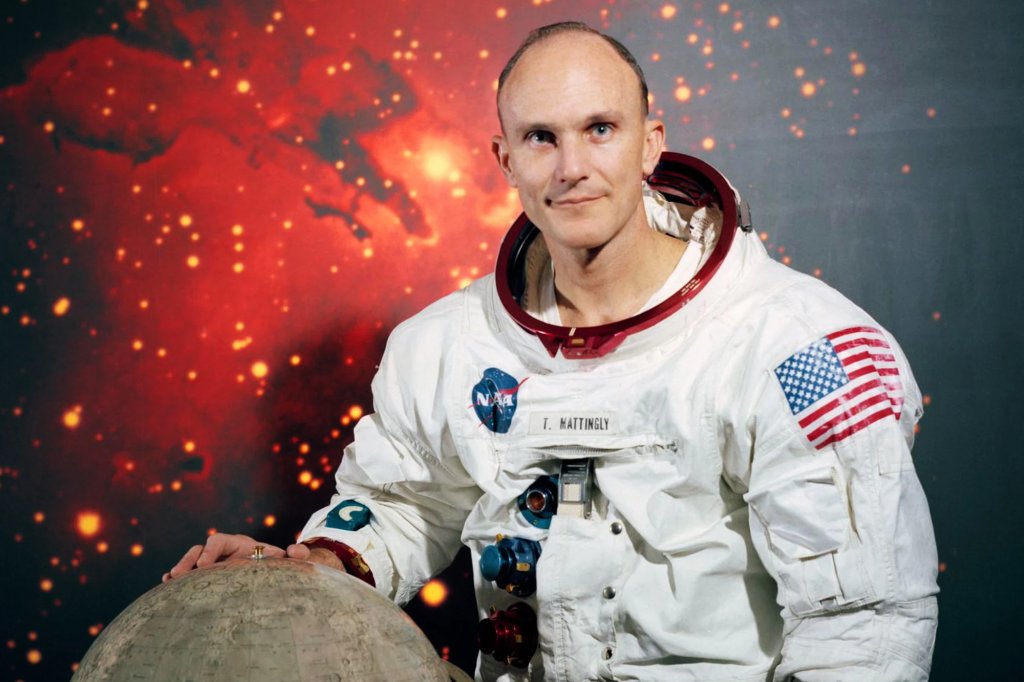

Thomas Kenneth Mattingly II was a Naval aviator, aeronautical engineer, test pilot and NASA astronaut who flew on both Apollo and Space Shuttle missions. Portrayed by Gary Sinise in the 1995 film Apollo 13, Mattingly was replaced by astronaut Jack Swigert on the Apollo 13 crew after exposure to measles. Instead, Mattingly flew on Apollo 16.
Born in Chicago, Illinois, on March 17, 1935, Mattingly’s father’s job with Eastern Airlines moved the family to Florida soon after. As a Boy Scout, the young Mattingly obtained the rank of Life Scout. After graduating from Miami Edison High School in 1954, he attended Auburn University, where he earned a Bachelor of Science degree in Aeronautical Engineering in 1958. That year, he commissioned into the Navy as an ensign and attended flight school. Mattingly earned his wings of gold in 1960.

After becoming rated as a Naval aviator, Mattingly was assigned to Attack Squadron Thirty-five (VA-35) at NAS Oceana, Virginia. From 1960-1963, he flew Douglas A-1H Skyraiders aboard the USS Saratoga (CVA-60) before transferring to Heavy Attack Squadron Eleven (VAH-11) at NAS Sanford, Florida. There, he flew Douglas A-3B Skywarriors for two years and deployed aboard the USS Franklin D. Roosevelt (CVA-42). At NAS Sanford, Mattingly participated in an aerial photo reconnaissance mission during which he observed the launch of Gemini 3 at Cape Canaveral.
After completing his second cruise, Mattingly was accepted to the U.S. Air Force Aerospace Research Pilot School at Edwards AFB, California, where he was classmates with fellow future astronauts Edgar Mitchell and Karol Bobko. His instructors, Charles Duke and Henry Hartsfield, Jr., were also Mattingly’s crewmates aboard Apollo 16 and STS-4, respectively. In April 1966, while still in school, he was selected by NASA for astronaut training.

Following completion of astronaut training, Mattingly served on the support crew for Apollo 8 and was the backup Command Module Pilot for Apollo 11, parallel with Bill Anders. Pulled up to the prime crew for Apollo 13, Mattingly was removed following exposure to measles, which he did not end up contracting. Although he was not aboard the spacecraft for the infamous in-flight explosion, Mattingly was a critical part of the ground team that safely brought the crew of Apollo 13 safely home.

Serving as Command Module Pilot for Apollo 16, Mattingly performed an extravehicular activity to retrieve film and data packages from the science bag side of the service module during the return to Earth. This was the second deep-space EVA performed at great distance from a planetary body, one of only three to take place. After Apollo, Mattingly served in managerial positions of the Space Shuttle development program.

On June 27, 1982, Mattingly commanded STS-4, the fourth and final orbital test flight of Space Shuttle Columbia. After launching from Kennedy Space Center, Florida, the seven-day mission saw the shuttle complete 112 orbits of Earth before landing at Edwards AFB, California. On January 24, 1985, Mattingly commanded STS-51-C, the first Space Shuttle Department of Defense mission. Launched from Kennedy Space Center, Space Shuttle Discovery successfully deployed a modified Inertial Upper Stage vehicle before landing on January 27, 1985.

In June 1985, Mattingly retired from NASA. The next year, he retired from the Navy as a Read Admiral (upper half). Entering the private sector, Mattingly served as Director of Grumman’s Space Station Support Division. After, he worked for General Dynamics in San Diego, California, where he led the Atlas booster program. Mattingly also served as a Vice President at Lockheed Martin in charge of the X-33’s development.

Mattingly logged 7,200 flight hours and 21 days, 4 hours and 34 minutes in space. Moreover, he accumulated 1 hour and 23 minutes total EVA time. His awards include the NASA Distinguished Service Medal, the Navy Distinguished Service Medal and the NASA Space Flight Medal. He was also inducted into the International Space Hall of Fame in 1983 and the U.S. Astronaut Hall of Fame in 1997. Mattingly passed away in Arlington, Virginia, on October 31, 2023, at the age of 87.
